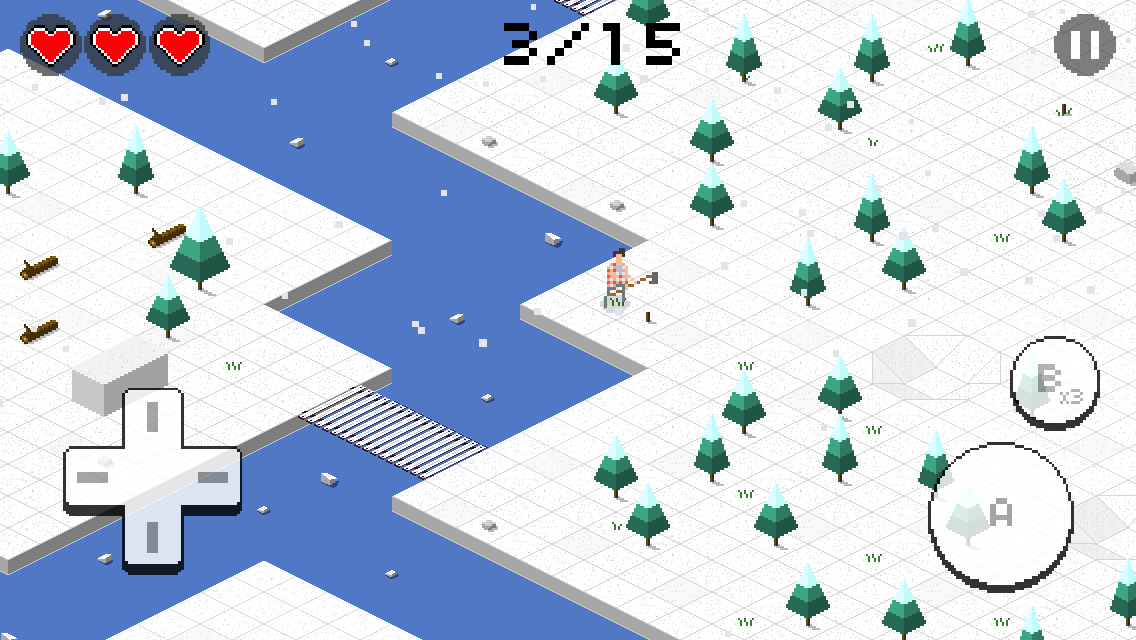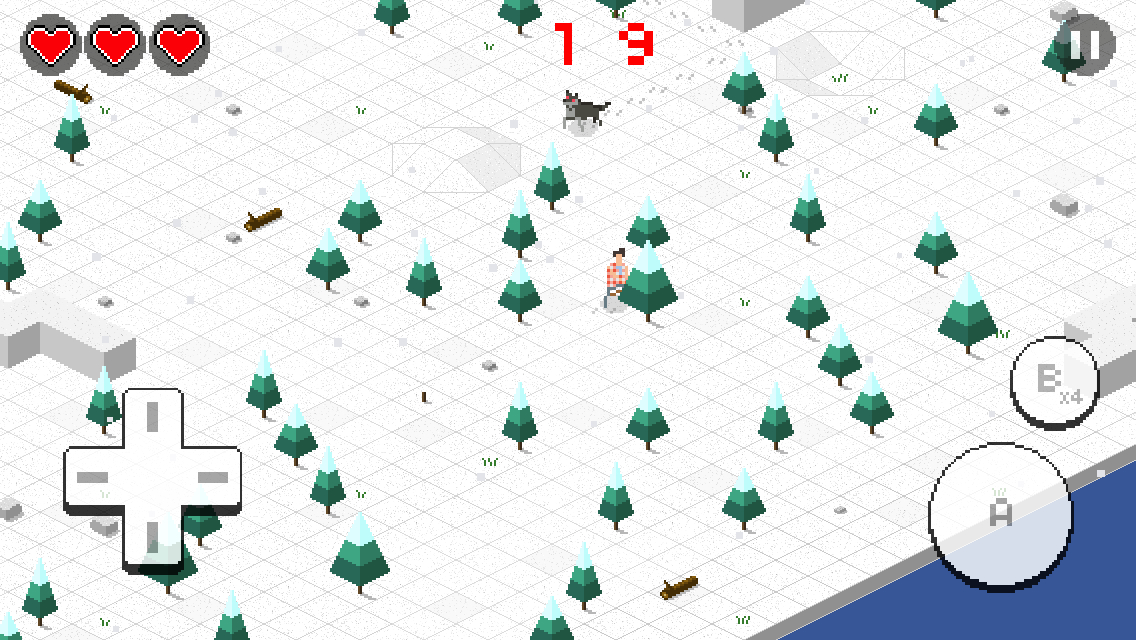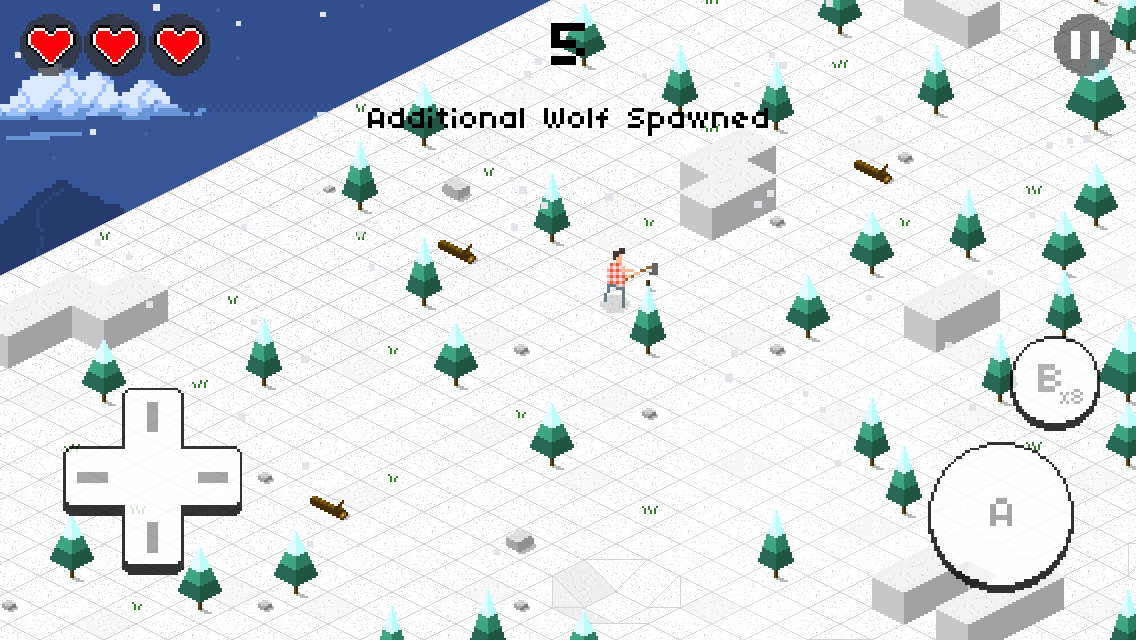![]() Boshi ($0.99) is one of those games that focuses on delivering a simple but unique core gameplay concept, with little room for frills or extras. It’s the kind of game that wouldn’t have been out of place in the earlier eras of gaming. It’s actually kind of similar to Pac-Man ($3.99) in a lot of ways. You play as a lumberjack, and your goal in each stage is to cut down all of the large trees. Each tree will come down with five good swings of your axe. Wherever it’s possible, you’ll want to do this without attracting any nearby wolves, who are alerted by your proximity and the sound of your chopping, and will chase you down and kill you if they catch you. Each stage has a set layout, so the trees, rivers, bridges, and so on will be the same each time you tackle a level. The wolves wander around in set patterns, though obviously if you get in a chase with them, they’ll end up in different places before wandering back to their original area.
Boshi ($0.99) is one of those games that focuses on delivering a simple but unique core gameplay concept, with little room for frills or extras. It’s the kind of game that wouldn’t have been out of place in the earlier eras of gaming. It’s actually kind of similar to Pac-Man ($3.99) in a lot of ways. You play as a lumberjack, and your goal in each stage is to cut down all of the large trees. Each tree will come down with five good swings of your axe. Wherever it’s possible, you’ll want to do this without attracting any nearby wolves, who are alerted by your proximity and the sound of your chopping, and will chase you down and kill you if they catch you. Each stage has a set layout, so the trees, rivers, bridges, and so on will be the same each time you tackle a level. The wolves wander around in set patterns, though obviously if you get in a chase with them, they’ll end up in different places before wandering back to their original area.
Your only defense against the wolves is your trusty flare gun, which will scare away any nearby wolves and incapacitate them for a short period. Naturally, the gun has limited ammo, a set amount of shots per stage that cannot be refilled or replenished during play. You’ll only want to use these when you’re in a serious pinch or need to access a tree that is otherwise hard to get at. Boshi can take three hits, technically, but if a wolf gets next to you, it’s pretty easy to lose all three hearts before you can get away. It’s pretty likely you’ll be spotted by wolves more times than you have flares, so you’ll have to get good at the first key point of Boshi: running away. If you run long enough, the wolves will give up the chase, provided you don’t run into yet another wolf in the process. In the first half of the game, it’s fairly easy to shake a wolf and get back to business as usual, but after that, you’ll find the wolves are laid out in such a way that you tend to run into the next wolf before you’ve shaken the first. It’s at this point that you’ll have to learn the second key point of the game, which is the chop and run.

It takes five chops to take down a tree, but you don’t have to do them all at the same time. You can chop once here, two more times there, then finish it off with three the next time you run by. It’s a bit manic, and it’s a lot of fun. There are a lot of things to juggle in the heat of the moment, like trying to gain enough ground on the wolves chasing you to make a couple more chops on the tree ahead, dodging the other smaller trees that just serve to get in your way, doing your best to not box yourself in on an incline, and keeping your eye out for any remaining trees so that you can plan your next course. The more time you invest into Boshi, the more enjoyable it becomes. It does take an investment of time, however, due to the game’s biggest problem.
As I mentioned at the beginning of the review, Boshi wouldn’t feel out of place in one of gaming’s earlier periods. There’s just one problem with that, though, and it’s that touch screen controls didn’t exist back then. Boshi uses a virtual directional pad and two virtual buttons, and while the buttons are fine, the movement is stiff and sometimes unresponsive. The game is already sporting an isometric point of view that makes navigating a little more tricky than you might be used to, so it really didn’t need any issues adding to that. As a result of this, it takes a while for Boshi to click, and even when it does, there’s a good chance the controls will get you killed sometimes anyway. It makes for a very poor first impression, and along with the fact that the game doesn’t explain itself well at all, you’d be easily forgiven if Boshi turned you off for good in the very first play.

If you do decide you want to try to weather that rocky start, I’d recommend starting with the endless mode. When I first played the game, I tried doing the stages, but I had no idea what the game was really about and didn’t make much progress. After spending some time surviving the endless mode, I was able to pick up a lot of good gameplay skills that helped me make my way through the regular stages. The game loads up by default in portrait mode, and that’s a pretty bad way to play the game. If you unlock your screen orientation, the game is playable in a much more enjoyable landscape view that spaces out the virtual buttons and lets you see more of the stage around you, which is vital for survival. Once you get the hang of the game, the 12 levels can go by pretty quickly, but you can always go back to them and try to earn a higher score, or just head back to the endless mode to see how far you can go.
The presentation for the most part mirrors the gameplay. It’s simple and retro-style, but it conveys what it needs to at a glance, with my only issues with the visuals being that it’s not always easy to notice inclines in the middle of the action. The sound does its job of warning you when you’ve been spotted and such, while the music is kind of a laidback tune that matches the snowy landscapes well but not the frantic gameplay. There is Game Center support for leaderboards, but sadly no achievements. I always feel that games with focused gameplay but minimal content like Boshi can benefit greatly from a fun list of extra goals to aim for, so it’s unfortunate there’s nothing like that here.

If you can hang in there to the point of becoming accustomed to the lumberjack’s stiff movement and the game’s unexpected flow, you’ll find a slightly more strategic take on Pac-Man‘s grab and run gameplay that definitely has its moments of enjoyable tension. That’s a pretty heavy condition, though, and I’m not sure that what you get out of the game is worth dealing with it. If you’re on the hunt for something simple and odd, and you have a fair bit of patience, you might want to give Boshi a try. I think it’s going to turn off more people than it catches, but the latter group should get their dollar’s worth out of the game.